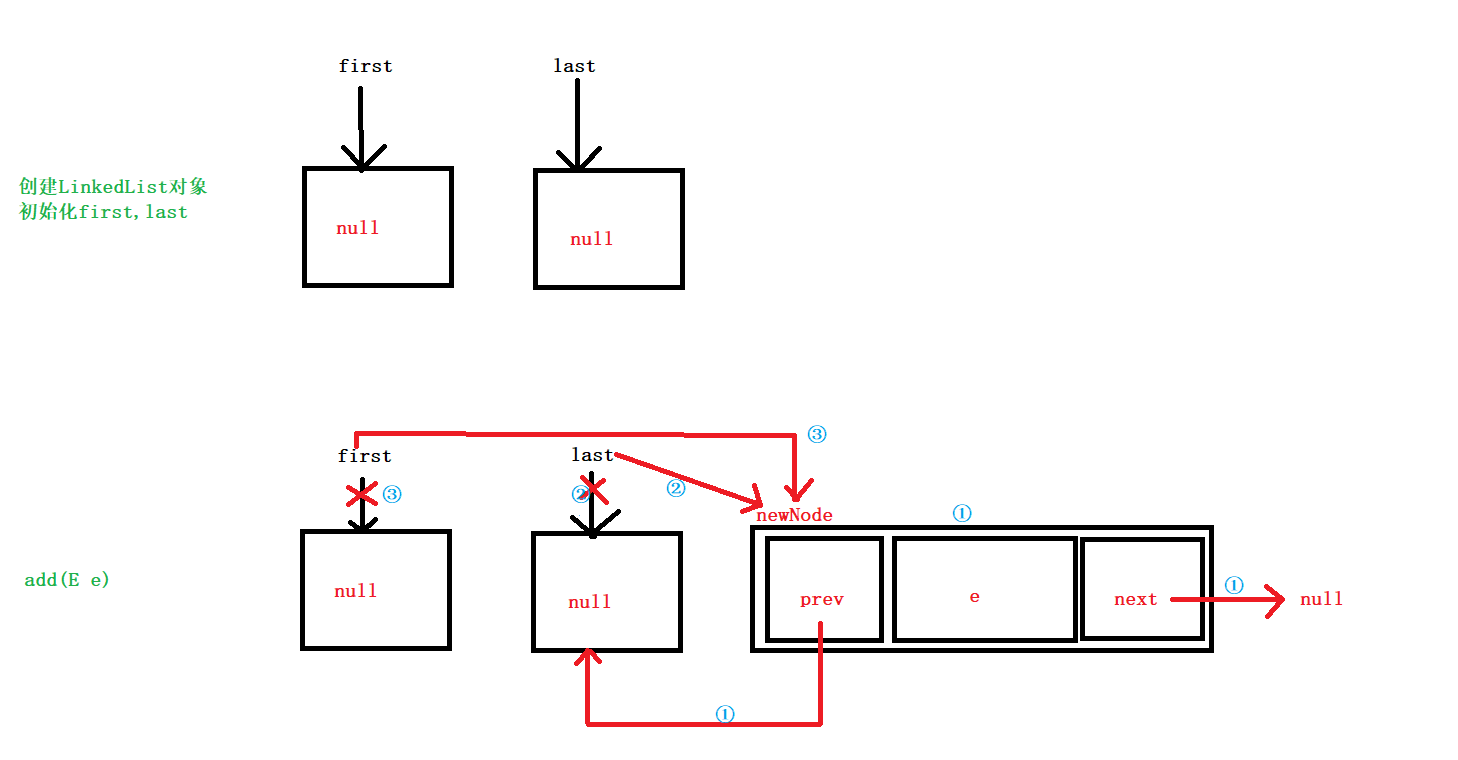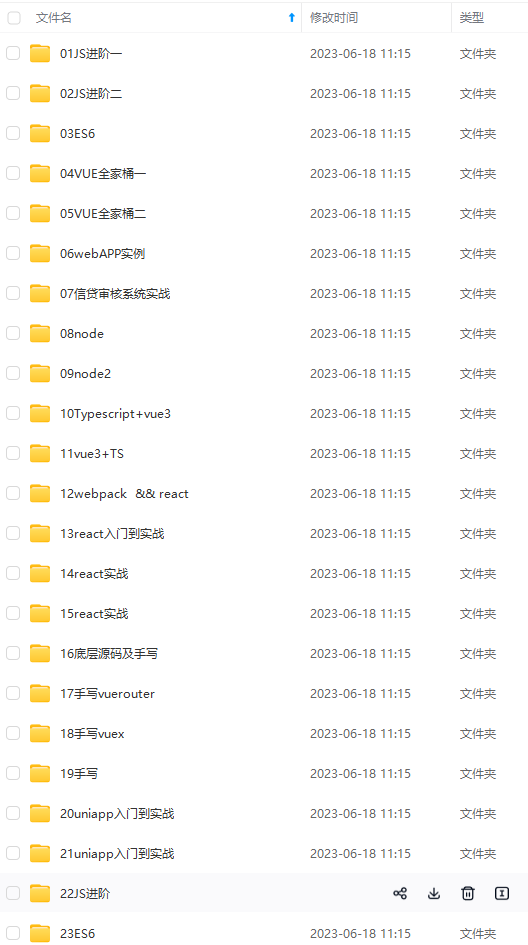
List集合之LinkedList(一)通过源码看特性,神级前端进阶笔记
技术学到手后,就要开始准备面试了,找工作的时候一定要好好准备简历,毕竟简历是找工作的敲门砖,还有就是要多做面试题,复习巩固。CodeChina开源项目:【大厂前端面试题解析+核心总结学习笔记+真实项目实战+最新讲解视频】unlink(x);remove(Object o)分两种情况:1. o == null,此时删除LinkedList底层双向链表的第一个元素为null的节点。2. o!= nul
addAll©;
}
LinkedList有两个构造器,一个无参构造器,一个带参Collection c构造器。
当我们使用无参构造器创建LinkedList对象时,该对象只是初始化了first=null,last=null
当我们使用LinkedList(Collection c)创建对象时,内部调用了addAll(Collection c)方法,具体到addAll(Collection c)方法中讨论。
插入元素
====
常用方法
boolean add(E e)
/**
-
Appends the specified element to the end of this list.
-
This method is equivalent to {@link #addLast}.
-
@param e element to be appended to this list
-
@return {@code true} (as specified by {@link Collection#add})
*/
public boolean add(E e) {
linkLast(e);
return true;
}
/**
- Links e as last element.
*/
void linkLast(E e) {
final Node l = last;
final Node newNode = new Node<>(l, e, null);
last = newNode;
if (l == null) // 我们知道当l为null时,即老的last为null,则说明对应的prev也是null,即链表是一个空链表。
first = newNode;// 若为空链表,则插入的节点就是链表的唯一节点,既是last,也是first
else
l.next = newNode;// 若为非空链表,则需要将老的last节点的next指向新的last节点
size++; // size是LinkedList的成员属性,初始值为0,加入一个元素后,size++为1
modCount++;// modCount变更可知该操作是集合结构化修改操做
}
从上面代码可以看出 add(E e)方法是在链表尾部插入一个节点。
下面画图演示在一个空链表中add(E e)

结合代码和图示:
第一步:先创建新节点e,e节点的prev指向了last,next指向了null
第二步:由于新节点e是插入到链表尾部,所以e节点是新的last节点
第三步:判断老的last节点是否为null,即插入e节点前,链表是否为空链表
若为空链表,则将first也指向e节点。
即当前链表只有一个节点,既是first 也是last
下面画图演示在一个非空链表中add(E e)

第一步:创建新节点e2,其中prev2指向last,next2指向null
第二步:由于e2节点是插入到链表尾部,所以e节点是新的last
第三步:判断老的last,即e节点是否为null,
若不为null,则链表不是空链表,则将e节点的next指向新的last,即e2
上述两种情况就是 linkLast(E e)的实现。
void add(int index, E element)
/**
-
Inserts the specified element at the specified position in this list.
-
Shifts the element currently at that position (if any) and any
-
subsequent elements to the right (adds one to their indices).
-
@param index index at which the specified element is to be inserted
-
@param element element to be inserted
-
@throws IndexOutOfBoundsException {@inheritDoc}
*/
public void add(int index, E element) {
checkPositionIndex(index);
if (index == size)
linkLast(element);
else
linkBefore(element, node(index));
}
private void checkPositionIndex(int index) {
if (!isPositionIndex(index))
throw new IndexOutOfBoundsException(outOfBoundsMsg(index));
}
/**
-
Tells if the argument is the index of a valid position for an
-
iterator or an add operation.
*/
private boolean isPositionIndex(int index) {
return index >= 0 && index <= size;
}
/**
- Returns the (non-null) Node at the specified element index.
*/
Node node(int index) {
// assert isElementIndex(index);
if (index < (size >> 1)) {
Node x = first;
for (int i = 0; i < index; i++)
x = x.next;
return x;
} else {
Node x = last;
for (int i = size - 1; i > index; i–)
x = x.prev;
return x;
}
}
/**
- Inserts element e before non-null Node succ.
*/
void linkBefore(E e, Node succ) {
// assert succ != null;
final Node pred = succ.prev;
final Node newNode = new Node<>(pred, e, succ);
succ.prev = newNode;
if (pred == null)
first = newNode;
else
pred.next = newNode;
size++;
modCount++;
}
add(int index, E element)方法是将element加到链表的index位置
首先链表结构不像数组(每个元素都有索引)一样,链表节点是没有索引的。所以这里的index并不是指元素的索引。
但是链表节点是有顺序性的,我们可以按照从first节点到last节点排序号,first节点就是序号0,last节点就是序号size-1 (size>=1时)。所以可以将index理解为序号。
那么链表元素是如何实现排序的呢?通过之前的图示我们知道 上一个节点的next指向下一个节点,下一个节点的prev指向上一个节点。
所以 first 的 index =0
则 first.next 的 index= 1
则 first.next.next 的 index = 2
…
则 last为 index = size -1
同样的,LinkedList是双向链表,具有双向性
所以 last 的 index = size -1
则 last.prev 的 index = size - 2
则 last.prev.prev 的 index = size - 3
…
则 first 的 index = 0
可以看出LinkedList底层双向链表查找对应index的元素,不像数组那样具有随机访问性,而是必须从first->last 或 last->first一个一个查询,所以LinkedList查询效率低。
而为了提升一点查询效率,Java大佬们使用了二分法查询。即:
若 index < size*0.5,则说明该索引在链表的前半部分,则可以从first->last方向查询
若index >= size*0.5,则说明该索引在链表的后半部分,则可以从last->first方向查询
具体代码实现如下
/**
- Returns the (non-null) Node at the specified element index.
*/
Node node(int index) {
// assert isElementIndex(index);
if (index < (size >> 1)) {
Node x = first;
for (int i = 0; i < index; i++)
x = x.next;
return x;
} else {
Node x = last;
for (int i = size - 1; i > index; i–)
x = x.prev;
return x;
}
}
以上解释了LinkedList的元素索引的实现。下面继续讨论add(int index, E element)方法
add(int index, E element)方法可以分为三种情况讨论
当index=0时,说明element将要被插入到链表头部,此时只关注element和first
当index=size时,说明element将要被插入到链表尾部,此时只关注element和last
当 0<index<size 时,说明element将要被插入到链表中间,此时需要关注element和前后两个节点
Java这里将 index = size 归为了 linkLast(element),关于linkLast实现和add(E e)方法中实现一致,不再赘述。
将 index<size 归为了 linkBefore(element,node(index))
下面图示linkBefore(E e, Node succ)实现,其中e是将要被插入到index位置新节点的元素,succ是插入前,链表中index位置的节点

从add(e,0)图示可以看出:
第一步:创建newNode节点,newNode.prev指向了Node0.prev,newNode.next指向了Node0
第二步:解开Node0与前一个节点的连接,即Node0.prev改为指向newNode,将Node0作为newNode的下一个节点
第三步:由于Node0已经不是头节点了,所以first改为指向newNode

从add(e,1)图示可以看出:
第一步:创建newNode节点,newNode.prev指向了Node1.prev,newNode.next指向了Node1
第二步:解开Node1和前一个节点的连接,即Node1.prev改为指向newNode,将Node1作为newNode的下一个节点
第三步:由于Node1本来就不是头节点,所以还需要解开Node1上一个节点Node0的next连接约束,即将Node0.next指向newNode
boolean addAll(Collection<? extends E> c)
/**
-
Appends all of the elements in the specified collection to the end of
-
this list, in the order that they are returned by the specified
-
collection’s iterator. The behavior of this operation is undefined if
-
the specified collection is modified while the operation is in
-
progress. (Note that this will occur if the specified collection is
-
this list, and it’s nonempty.)
-
@param c collection containing elements to be added to this list
-
@return {@code true} if this list changed as a result of the call
-
@throws NullPointerException if the specified collection is null
*/
public boolean addAll(Collection<? extends E> c) {
return addAll(size, c);
}
通过源码可以看到addAll(Collection c)内部是调用另一个重载方法addAll(size,c)
可以简单看出addAll(Collection c)是将Collection c中的元素存储到LinkedList的size位置,即当前链表的尾部。
具体Collection c中的元素按何种顺序存入,请看下面allAll(int index,Collection c)的实现。
boolean addAll(int index, Collection<? extends E> c)
/**
-
Inserts all of the elements in the specified collection into this
-
list, starting at the specified position. Shifts the element
-
currently at that position (if any) and any subsequent elements to
-
the right (increases their indices). The new elements will appear
-
in the list in the order that they are returned by the
-
specified collection’s iterator.
-
@param index index at which to insert the first element
-
from the specified collection -
@param c collection containing elements to be added to this list
-
@return {@code true} if this list changed as a result of the call
-
@throws IndexOutOfBoundsException {@inheritDoc}
-
@throws NullPointerException if the specified collection is null
*/
public boolean addAll(int index, Collection<? extends E> c) {
checkPositionIndex(index);
Object[] a = c.toArray();// 将c集合转为数组a
int numNew = a.length;
if (numNew == 0)// 如果a.length==0,表示集合c是个空集合
return false;// 返回false表示添加失败
Node pred, succ;// 定义两个节点 插入节点前面的节点pred,插入节点后面的节点succ
if (index == size) {// 如果index==size,说明将c集合元素插入到当前链表尾部
succ = null;// 由于插入节点是插入到尾部,所以succ不存在
pred = last;// 由于插入节点是插入到尾部,所以pred是last节点
} else {// 如果插入节点插入到当前链表中间或头部
succ = node(index);// 则需要获取插入位置index的节点作为 插入节点后面的节点
pred = succ.prev;// 将succ前面的节点作为 插入节点的前一个节点
}
for (Object o : a) {
@SuppressWarnings(“unchecked”) E e = (E) o;
Node newNode = new Node<>(pred, e, null);// 定义插入节点
if (pred == null) // 如果插入节点前面的节点是null,则说明插入到了链表头部
first = newNode;// 则插入节点是第一个节点,即为头节点first
else //如果插入节点前面的节点不是null,则说明插入位置不是头部
pred.next = newNode; 则插入节点的前一个节点的next改为指向插入的节点
pred = newNode; // 将插入节点作为最小的pred,而后循环此流程
}
if (succ == null) { // 如果插入节点是插入到尾部
last = pred;//所以最后一个插入节点就是尾节点last
} else {// 否则说明插入位置不是尾部,则最后一个插入节点的next要指向succ,且succ要指向最后一个插入节点
pred.next = succ;
succ.prev = pred;
}
size += numNew;// LinKedList的元素数量增加c集合元素个数
modCount++;// 集合已被结构化修改
return true;// 返回插入成功
}
addAll(int index, Collection c)的实现思路和add(int index,E e)差不多,都分为两种情况:
1.是在链表尾部插入c集合元素,即插入位置index=size
2.是在链表头部或中间插入c集合元素,即插入位置0=<index<size
只考虑主体逻辑,该方法的实现关键是定义了两个特殊节点pred,succ。
pred指代 新节点的插入位置的前面一个节点
succ指代 新节点的插入位置的后面一个节点
当情况1时,即插入在当前链表尾部时,即pred是当前链表的last节点,succ不存在
当情况2,插入到当前链表头部时,即pred是null,succ是first节点
当情况2,插入到当前链表中间时,即pred是node(index-1),succ是node(index)
而这里的新节点可以理解成一个双向链表段,它会按照c.toArray()的数组元素顺序组成一个双向链表段。
void addFirst(E e)
/**
-
Inserts the specified element at the beginning of this list.
-
@param e the element to add
*/
public void addFirst(E e) {
linkFirst(e);
}
/**
- Links e as first element.
*/
private void linkFirst(E e) {
final Node f = first;
final Node newNode = new Node<>(null, e, f);
first = newNode;
if (f == null)
last = newNode;
else
f.prev = newNode;
size++;
modCount++;
}
插入元素到链表头部,方法名友好。体现了LinkedList的底层是个双向不循环链表。
void addLast(E e)
/**
-
Appends the specified element to the end of this list.
-
This method is equivalent to {@link #add}.
-
@param e the element to add
*/
public void addLast(E e) {
linkLast(e);
}
和add(E e)实现相同,只是方法名更加友好。体现了LinkedList的底层是个双向不循环链表。
特性证明
集合元素元素类型可以不一致,但是必须是引用类型。
该特性可以从节点Node(Node pre,E e,Node next)定义可知,其中e是集合元素,E是指e的类型,E是泛型,如果不指定泛型的话,那E就是默认的Object类型。而所有引用类型都可以向上转型为Object类型。
集合的容量是动态的
LinkedList的底层是双向链表。
它和ArrayList存储机制不一样,ArrayList底层是数组,数组的特点是使用前必须初始化,即数组使用前必须要确定长度。
ArrayList的动态容量实现是创建新数组来实现扩容。
而链表使用前不需要确定长度,或容量,链表的容量是真正的动态的。所以LinkedList的容量是动态的。
LinkedList集合元素是有序的
LinkedList的集合元素的有序性体现在
上一个节点的next指向下一个节点
下一个节点的prev指向上一个节点
LinkedList集合元素可以重复
LinkedList的add操作没有做添加元素的重复性检查操作,所以LinkedList的集合元素是可重复的。
获取元素
====
常用方法
E get(int index)
/**
-
Returns the element at the specified position in this list.
-
@param index index of the element to return
-
@return the element at the specified position in this list
-
@throws IndexOutOfBoundsException {@inheritDoc}
*/
public E get(int index) {
checkElementIndex(index);
return node(index).item;
}
private void checkElementIndex(int index) {
if (!isElementIndex(index))
throw new IndexOutOfBoundsException(outOfBoundsMsg(index));
}
/**
- Tells if the argument is the index of an existing element.
*/
private boolean isElementIndex(int index) {
return index >= 0 && index < size;
}
/**
- Returns the (non-null) Node at the specified element index.
*/
Node node(int index) {
// assert isElementIndex(index);
if (index < (size >> 1)) {
Node x = first;
for (int i = 0; i < index; i++)
x = x.next;
return x;
} else {
Node x = last;
for (int i = size - 1; i > index; i–)
x = x.prev;
return x;
}
}
E get(int index)用于获取链表中index位置的节点的元素。
关于链表节点的索引,在前面已经讨论过了。链表节点不具备索引能力,体现在LinkedList上的索引能力是通过Node node(int index)方法实现的。
Node node(int index)方法,将first节点当成索引0,first.next节点当成索引1,first.next.next节点当成索引2,…,last节点当成索引size-1,
也可以将last节点当成索引size-1,last.prev节点当成size-2,last.prev.prev节点当成索引size-3,…,first节点当成索引0
Node node(int index)方法采用二分法查询,提升了查询效率。
E getFirst()
/**
-
Returns the first element in this list.
-
@return the first element in this list
-
@throws NoSuchElementException if this list is empty
*/
public E getFirst() {
final Node f = first;
if (f == null)
throw new NoSuchElementException();
return f.item;
}
getFirst()方法用于获取链表first节点的元素。如果没有first节点,则抛出无此元素异常。
E getLast()
/**
-
Returns the last element in this list.
-
@return the last element in this list
-
@throws NoSuchElementException if this list is empty
*/
public E getLast() {
final Node l = last;
if (l == null)
throw new NoSuchElementException();
return l.item;
}
getLast()方法用于获取链表last节点的元素。如果没有last节点,则抛出无此元素异常。
特性证明
LinkedList集合元素有索引
LinkedList底层是双向链表,双向链表节点本身没有索引概念,但是有顺序概念。
所以LinkedList将底层双向链表的first节点当成索引0节点,后面节点(前面节点.next)索引依次加1,直到last节点的索引为size-1。
需要注意地是:LinkedList根据索引访问集合元素,并不像ArrayList那样访问具有随机性。LinkedList访问集合元素只能从first->last方向一个个找,或者从last->first方向一个个找。
这更加证明了LinkedList的元素索引是伪索引。
修改元素
====
常用方法
E set(int index, E element)
/**
-
Replaces the element at the specified position in this list with the
-
specified element.
-
@param index index of the element to replace
-
@param element element to be stored at the specified position
-
@return the element previously at the specified position
-
@throws IndexOutOfBoundsException {@inheritDoc}
*/
public E set(int index, E element) {
checkElementIndex(index);
Node x = node(index);
E oldVal = x.item;
x.item = element;
return oldVal;
}
set(int index, E element)方法就是简单地将index索引处节点的元素改为element。
删除元素
====
常用方法
E remove()
/**
-
Retrieves and removes the head (first element) of this list.
-
@return the head of this list
-
@throws NoSuchElementException if this list is empty
-
@since 1.5
*/
public E remove() {
return removeFirst();
}
remove()方法用于删除LinkedList底层双向链表的first节点
内部实现是调用removeFirst()方法,具体实现请看removeFirst()
E remove(int index)
/**
-
Removes the element at the specified position in this list. Shifts any
-
subsequent elements to the left (subtracts one from their indices).
-
Returns the element that was removed from the list.
-
@param index the index of the element to be removed
-
@return the element previously at the specified position
-
@throws IndexOutOfBoundsException {@inheritDoc}
*/
public E remove(int index) {
checkElementIndex(index);
return unlink(node(index));
}
/**
- Unlinks non-null node x.
*/
E unlink(Node x) {// x指要被删除的节点
// assert x != null;
final E element = x.item; // 取出x节点的item元素,后面删除成功后,会作为remove方法的返回值
final Node next = x.next;// 获取x节点的后一个节点next
final Node prev = x.prev;// 获取x节点的前一个节点prev
if (prev == null) {//如果x的前一个节点是null,则说明x节点是first
first = next;// 那么删除x节点后,x的后一个节点next就是新的first
} else { //如果x的前一个节点不是null,则说明x节点不是first
prev.next = next;// 那么删除x后,x的前一个节点的next指向改为x的后一个节点
x.prev = null; // 将x节点的prev指向改为null,达到从链中彻底删除x节点的目的
}
if (next == null) {// 如果x的后一个节点是null,则说明x节点是last
last = prev;// 则删除x之后,x的前一个节点就是新的last
} else {// 如果x的后一个节点不是null,则说明x节点不是last
next.prev = prev; // 则删除x节点后,x的后一个节点的prev指向改为x的前一个节点
x.next = null; // 将x节点的next指向改为null,达到从链中彻底删除x节点的目的
}
x.item = null;// 此时x的prev,next都已经被设置为了null,需要将x.item也设置为null,那么x节点对象就会变成垃圾,等待被垃圾回收器回收
size–;// 链表元素个数减一
modCount++;// 集合对象发生结构化修改
return element;//返回之前保存的被删除节点的元素
}
remove(int index)方法的主体逻辑是unlink(node(index))。下面我们解析下unlink(Node x)方法实现:
unlink方法入参的节点x是需要被删除的节点。通过走读unlink代码发现,其思路是:由于要删除x节点,那么删除x节点后,x的前后两个节点就要建立联系。unlink的主要目的就是建立x前后两个节点之间的联系。
Java大佬们将x的前一个节点 定义为 x_prev, 将x的后一个节点 定义为 x_next。在建立x_prev和x_next节点联系前,我们需要搞清楚x_prev和x_next的具体场景
1. 当x节点是链表的唯一节点时,删除了x节点,那么链表就变成了空链表,即first=x_prev=null,last=x_next=null
2. 当x节点不是链表的唯一节点时,且x节点是头节点时,x_prev是null,删除x节点对x_prev无影响。而删除x节点后,x_next就是头节点。则需要删除x节点和x_next之间的联系,以及建立x_next和x_prev的联系,即x.next=null, x_next.prev=x_prev
3. 当x节点时尾节点时,x_next是null,删除x节点对x_next无影响。而删除x节点后,x_prev就是尾节点。则需要删除x节点和x_prev之间的联系,以及建立x_prev和x_next的联系,即x.prev=null, x_prev.next=x_next
4. 当x节点时中间节点时,则需要删除x节点和x_next,x_prev之间的联系,即将x.prev=null,x.next=null。然后需要建立x_next和x_prev的联系,即x_prev.next = x_next, x_next.prev = x_prev。
经过Java大佬的凝结提炼得到如下代码:
if (prev == null) {
first = next;
} else {
prev.next = next;
x.prev = null;
}
if (next == null) {
last = prev;
} else {
next.prev = prev;
x.next = null;
}
该代码的妙处是将上面情况3的修改凝练到了情况1,2中。上面这段代码
两个if体组合是情况1
两个else体组合就是情况4
一个if和另一个if的else组合就是情况2,3
说实话,这种代码思维 比 逻辑思维更加缜密。如果从逻辑思维考虑的话,很可能就漏掉情况1。
boolean remove(Object o)
/**
-
Removes the first occurrence of the specified element from this list,
-
if it is present. If this list does not contain the element, it is
-
unchanged. More formally, removes the element with the lowest index
-
{@code i} such that
-
(o==null ? get(i)==null : o.equals(get(i)))
-
(if such an element exists). Returns {@code true} if this list
-
contained the specified element (or equivalently, if this list
-
changed as a result of the call).
-
@param o element to be removed from this list, if present
-
@return {@code true} if this list contained the specified element
*/
public boolean remove(Object o) {
if (o == null) {
for (Node x = first; x != null; x = x.next) {
if (x.item == null) {
unlink(x);
return true;
}
}
} else {
for (Node x = first; x != null; x = x.next) {
if (o.equals(x.item)) {
unlink(x);
return true;
}
}
}
return false;
}
remove(Object o)分两种情况:
1. o == null,此时删除LinkedList底层双向链表的第一个元素为null的节点。
2. o != null ,此时底层会调用o的equals方法去比较底层链表的每个节点的元素,匹配到的第一个元素节点删除
所以remove(Object o) 期望o的运行时类型重写了equals方法
E removeFirst()
/**
-
Removes and returns the first element from this list.
-
@return the first element from this list
-
@throws NoSuchElementException if this list is empty
*/
public E removeFirst() {
final Node f = first;
if (f == null)
throw new NoSuchElementException();
自我介绍一下,小编13年上海交大毕业,曾经在小公司待过,也去过华为、OPPO等大厂,18年进入阿里一直到现在。
深知大多数前端工程师,想要提升技能,往往是自己摸索成长或者是报班学习,但对于培训机构动则几千的学费,着实压力不小。自己不成体系的自学效果低效又漫长,而且极易碰到天花板技术停滞不前!
因此收集整理了一份《2024年Web前端开发全套学习资料》,初衷也很简单,就是希望能够帮助到想自学提升又不知道该从何学起的朋友,同时减轻大家的负担。






既有适合小白学习的零基础资料,也有适合3年以上经验的小伙伴深入学习提升的进阶课程,基本涵盖了95%以上前端开发知识点,真正体系化!
由于文件比较大,这里只是将部分目录大纲截图出来,每个节点里面都包含大厂面经、学习笔记、源码讲义、实战项目、讲解视频,并且后续会持续更新
如果你觉得这些内容对你有帮助,可以添加V获取:vip1024c (备注前端)

总结
技术学到手后,就要开始准备面试了,找工作的时候一定要好好准备简历,毕竟简历是找工作的敲门砖,还有就是要多做面试题,复习巩固。
CodeChina开源项目:【大厂前端面试题解析+核心总结学习笔记+真实项目实战+最新讲解视频】
if (o.equals(x.item)) {
unlink(x);
return true;
}
}
}
return false;
}
remove(Object o)分两种情况:
1. o == null,此时删除LinkedList底层双向链表的第一个元素为null的节点。
2. o != null ,此时底层会调用o的equals方法去比较底层链表的每个节点的元素,匹配到的第一个元素节点删除
所以remove(Object o) 期望o的运行时类型重写了equals方法
E removeFirst()
/**
-
Removes and returns the first element from this list.
-
@return the first element from this list
-
@throws NoSuchElementException if this list is empty
*/
public E removeFirst() {
final Node f = first;
if (f == null)
throw new NoSuchElementException();
自我介绍一下,小编13年上海交大毕业,曾经在小公司待过,也去过华为、OPPO等大厂,18年进入阿里一直到现在。
深知大多数前端工程师,想要提升技能,往往是自己摸索成长或者是报班学习,但对于培训机构动则几千的学费,着实压力不小。自己不成体系的自学效果低效又漫长,而且极易碰到天花板技术停滞不前!
因此收集整理了一份《2024年Web前端开发全套学习资料》,初衷也很简单,就是希望能够帮助到想自学提升又不知道该从何学起的朋友,同时减轻大家的负担。
[外链图片转存中…(img-1lnkGBZs-1711967012377)]
[外链图片转存中…(img-aXRYfJKr-1711967012378)]
[外链图片转存中…(img-Q7lRZHEc-1711967012378)]
[外链图片转存中…(img-V4LkAUZt-1711967012379)]
[外链图片转存中…(img-ktStnQGU-1711967012379)]
[外链图片转存中…(img-ryOzX617-1711967012379)]
既有适合小白学习的零基础资料,也有适合3年以上经验的小伙伴深入学习提升的进阶课程,基本涵盖了95%以上前端开发知识点,真正体系化!
由于文件比较大,这里只是将部分目录大纲截图出来,每个节点里面都包含大厂面经、学习笔记、源码讲义、实战项目、讲解视频,并且后续会持续更新
如果你觉得这些内容对你有帮助,可以添加V获取:vip1024c (备注前端)
[外链图片转存中…(img-AV0YIZkm-1711967012379)]
总结
技术学到手后,就要开始准备面试了,找工作的时候一定要好好准备简历,毕竟简历是找工作的敲门砖,还有就是要多做面试题,复习巩固。
CodeChina开源项目:【大厂前端面试题解析+核心总结学习笔记+真实项目实战+最新讲解视频】

更多推荐
 已为社区贡献4条内容
已为社区贡献4条内容









所有评论(0)